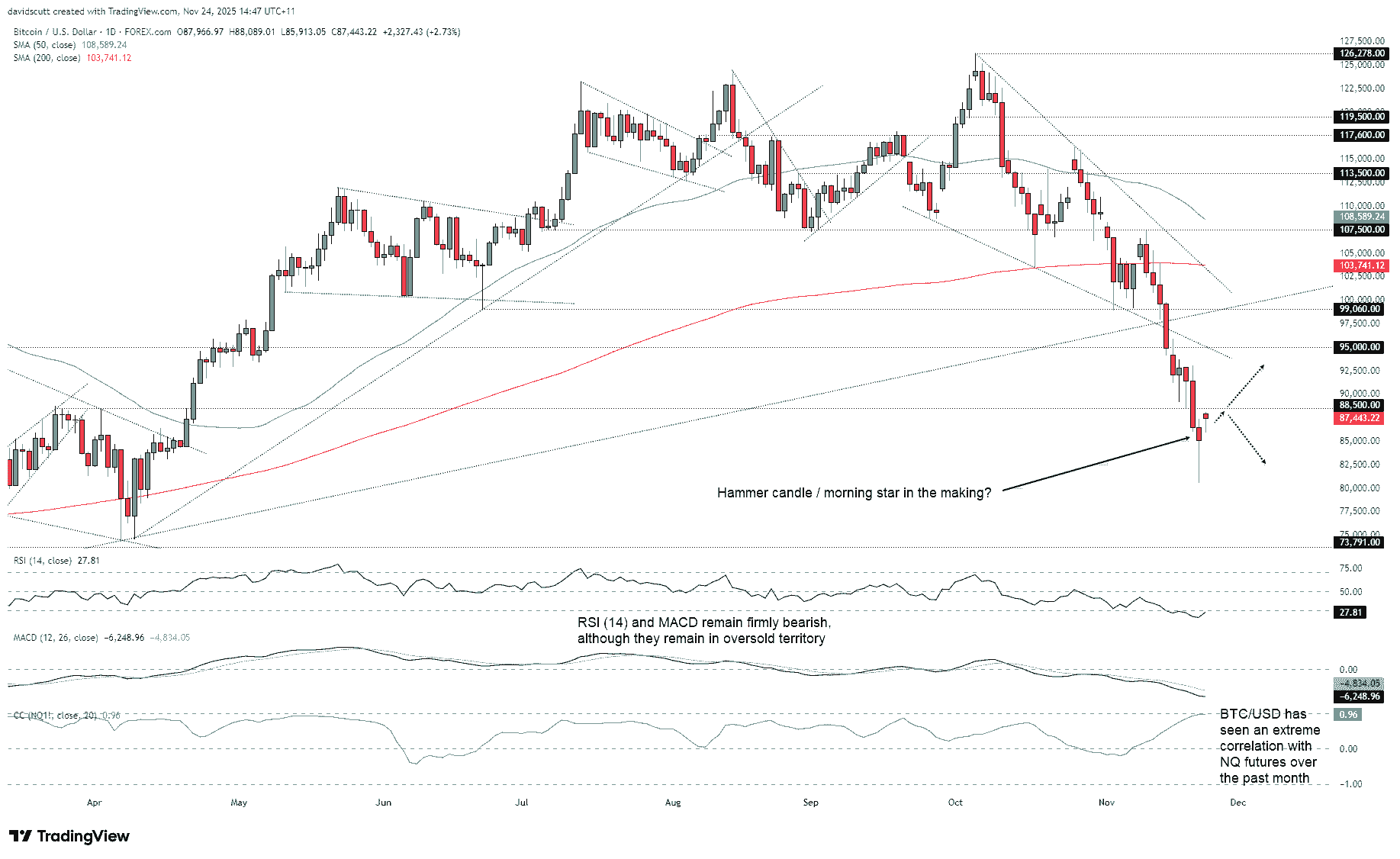S&P 500 could hit 8,000 in 2026 on more easing from Fed: JPMorgan
BTC/USD flashed a hammer candle Friday after plunging into oversold territory, hinting at a possible swing low. But with oscillators still bearish, is this a trap or the start of something bigger?
- Hammer candle signals possible reversal
- Oscillators still lean bearish
- Risk revival may lack staying power
Summary
Did we just see a swing low for BTC/USD? Based on the price action late last week, there are grounds for thinking so. A distinctive hammer candle printed on Friday, with BTC/USD reversing hard after falling deep into oversold territory. While the message from the oscillators remains firmly bearish—normally favoring short setups over long—the price action is providing a contradictory signal. Therefore, rather than acting on either immediately, BTC/USD looks like something to keep on the watchlist for Monday.
Bitcoin Eyes $88,500
$88,500 is worth keeping an eye on given it capped the price on several occasions back in March and April before temporarily halting the market rout last week. So far on Monday, BTC/USD has come close to testing the level, delivering a potential zone to build setups around depending on how near-term price action evolves.
Source: TradingView
Should BTC/USD push above $88,500 and hold there, longs could be established on the break with a stop beneath to protect against reversal. As that would likely deliver a three-candle morning star, it would further boost the prospects for considering long setups.
Like $88,500, $95,000 saw plenty of work either side of it earlier this year, initially acting as support in February before flipping to resistance in April. As such, it screens as an initial target to consider, along with former downtrend support located today around $94,000. If they were to be broken, $99,060 is the next topside level of note, acting as support earlier in the year.
Of course, should the bounce be sold into like so many before it, the setup could be flipped if the price were to remain beneath $88,500, allowing for shorts to be established with a stop above for protection. Friday’s low looms as a possible target, with a sustained move beyond that level opening the door for a run towards $75,000 where BTC/USD bottomed following the broader Liberation Day reciprocal tariff risk rout.
While I tend to put far more weight on price signals in BTC/USD as I suspect that’s a major factor underpinning its value, you can’t deny it often performs strongly when risk appetite is buoyant. That’s demonstrated in the bottom pane by the rolling 20-day correlation coefficient score it has with Nasdaq 100 futures, sitting at 0.96.
Does the Risk Revival Have Staying Power?
Even though risk assets are building on Friday’s bullish reversal in Asia on Monday, I have concerns about how long that will be sustained, especially given some of the fundamental factors cited behind it.
One was dovish remarks from New York Fed President John Williams on Friday about there being grounds for further policy easing near term given his assessment the funds rate remains in restrictive territory. While markets got excited by the comment, seeing pricing for a December rate cut shift to more likely than not, it’s hardly news that Williams thinks policy is restrictive: he’s been saying the same thing for months. He may be seen as a moderate voice on the FOMC, but the scale of the reaction hints traders were wrong-footed after continuously reducing the probability of a December cut in the days before his speech.
Another risk-positive news item was a timely report that the Trump Administration was considering allowing Nvidia (NASDAQ:NVDA) to export H200 chips to China, catching a market that was vulnerable to a squeeze following a large bearish reversal a session earlier following the chipmakers’ Q3 earnings report.
If the moves were more reflective of short-term positioning, it raises questions about whether the risk recovery has staying power, especially as broader concerns about AI overinvestment remain unresolved. Light volumes ahead of Thanksgiving also carry the potential to generate higher realised volatility.
